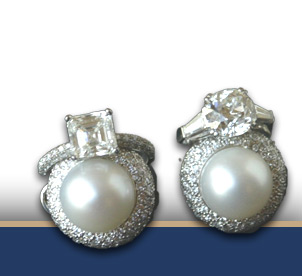|
Welcome to Heirloom Jewels' Gallery of antique
and estate jewelry.
In addition to the rings, brooches, necklaces,
earrings, and objets d’art featured for sale in our Web site
Boutique, Heirloom Jewels has an extensive
collection of diamond jewelry, precious gemstones, and jewels in
prices ranging from the affordable to the extravagant which you
can explore in our Gallery.
Our Gallery will help educate those who seek more
information on various jewelry styles, as well as reflect the wide
range of jewels and exquisite pieces available in Heirloom’s
collection.
For more information about any of the items featured
in our Gallery, please call Diane or Renee at 410-323-0100, or email
us at info@heirloomjewels.com.

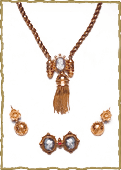
Click
image for detail
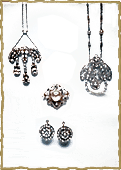
Click
image for detail |
Early
Victorian Jewelry
The early Victorian period, 1837-1860, dates back to the reign
of Queen Victoria of England. Popular motifs in jewelry during
this period include classical Greek and Roman designs, gothic
and medieval designs, and hearts. Cameos, made by carving away
background material to make a design in relief, were popular
during the Victorian era. For women they were set in rings,
brooches, earrings and bracelets; men wore them in watch fobs,
rings, and pins. The ancient Serpent motif (believed to be a
symbol of good luck) was revived during the Victorian era, as
rings, bracelets, or coiled on brooches. The Victorians had
a special love of coral jewelry (believed to possess the power
to ward off evil and danger). Other fashionable stones throughout
this period include amethyst, bloodstone, goldstone, jet, opals,
topaz, and garnets. Gold (all colors except white), gold-plated
and rolled gold were also commonly used in early Victorian period.

|
Mid-Victorian
Jewelry
The mid-Victoran era, 1860-1885, saw the popularity of Etruscan
motifs, archeological motifs, as well as acorns, bells, crosses,
buckles, fringes, tassels, monograms, and insects. The most
commonly used stones include amethysts, diamonds, emeralds,
coral, pearls, sapphire, cornelian, aquamarine, and tourmaline.

|
Late Victorian
/ Edwardian Jewelry
The late Victorian / Edwardian Period lasted from 1885 - 1910.
Platinum was a new entry into the jewelry world, typically paired
with diamonds and designed with delicate detail, a characteristic
which distinguishes the jewelry of this period. King Edward’s
passion for racing caused the horseshoe to become a decorative
motif — cuff links, fobs, pins and brooches were either made
in this shape or carried its motif. Also popular were good luck
motifs, clovers and shamrocks, crescents and stars, single and
double hearts, birds, flowers and insects.

|
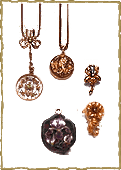
Click
image for detail |
Art Nouveau
The Art Nouveau style evolved during a very brief time — between
1890-1915. It developed at the end of the century, at a time
when there was a popular desire for the dramatic in dress and
jewelry. Characteristic of Art Nouveau designs are flowing lines
and asymmetry, with motifs including exotic flowers, plant shapes,
dragonflies, peacocks, sinister looking reptiles, and women
with mystical faces and long flowing hair. Materials used were
varied — horn, copper, tortoise-shell, ivory, carved glass,
shells, pearls, and semi-precious stones cut in cabochon. Amber
and near colorless stones such as opals and moonstones were
also frequently used in Art Nouveau jewelry, as was enameling.
Popular pieces included choker type necklaces or “dog collars,”
worn to compliment the popular high necklines, straight bar
pins, screw back and pierced earrings, and pendant necklaces.

|
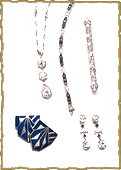
Click
image for detail |
Art Deco
Jewelry
Art Deco jewelry, popular during the 1920’s and 1930’s, featured
modernistic designs (geometric lines, abstract designs, stylized
floral motifs) and dramatic and shimmery colors, inspired by
the French “Art Decoratif” movement. Jewelry was used to compliment
the fashions of the period and to soften the effect the popular
short hair styles had on the features. Dangling earrings, long
ropes of beads (amber, bakelite, jeweled hat ornaments, and
wide jeweled bracelets, worn in numbers. Crystal and rhinestones
had become fashionable, along with emeralds, rubies, sapphires,
onyx, marcasites, cornelian, jade and ivory.

|
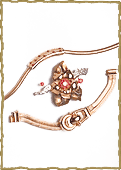
Click
image for detail |
Retro
Modern Jewelry
Produced during the 1940’s and 1950’s, Retro Modern jewelry
often features stylized flowers, stylized feathers, bows, and
birds in heavy designs with rubies and diamonds. Rose and yellow
gold were often used in retro modern jewelry, incorporating
pearls, faceted and cabochon stones, aquamarines, and synthetic
stones. Sterling Silver was used following W.W.II.

|
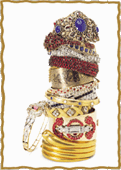
Click
image for detail |
Bracelets
From elegant bracelets of platinum and diamonds, to fun-to-wear
bangles of gold and cabochon stones, Heirloom Jewels has an
ever-changing selection in a wide range of prices.

|

Click
image for detail |
Rings
Heirloom’s extensive selection of rings for every occasion —
traditional diamond engagement rings, extravagant gem stone
cocktail rings, and every style in between.

|
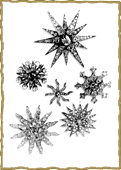
Click
image for detail |
Pins
Heirloom Jewels has become known for its extensive selection
of quality diamonds and gem stones, from a simple collar pin
to an elegant evening brooch.

|
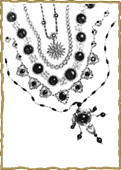
Click
image for detail |
Necklaces
Heirloom’s wide selection of necklaces ranges from Victorian
pendants, to classic pearls, to diamond chokers. |
|
|









